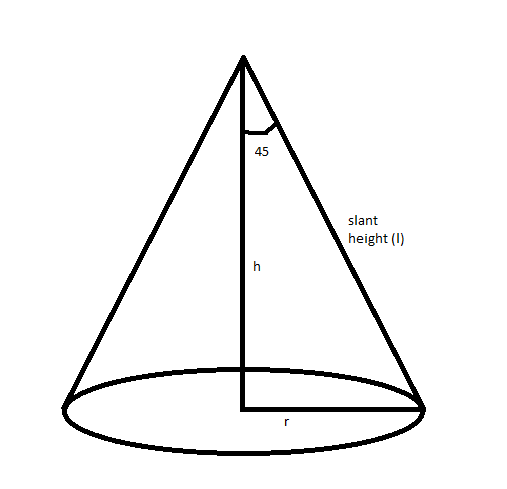
The semi-vertical angle of a cone is
A.
B.
C.
D. None of these
Answer
522k+ views
Hint: First of all, find the slant height of the cone and relation between radius and height of the cone by the given semi-vertical angle. Now, the approximate lateral surface area of the cone is given by
Complete step-by-step answer:
Let

From the figure,
We know that
So, slant height of the given cone is
Let
So,
We know that the lateral surface area of the cone with radius
So, the lateral surface area of the given cone is
The approximate lateral surface area of the cone is given by
Now, consider
And
Hence the approximate value of lateral surface area of the cone is
Thus, the correct option is A.
Note: The semi-vertical angle of the cone is the angle between the height and slant height of the cone. The slant height of the cone of radius
Complete step-by-step answer:
Let

From the figure,
We know that
So, slant height of the given cone is
Let
So,
We know that the lateral surface area of the cone with radius
So, the lateral surface area of the given cone is
The approximate lateral surface area of the cone is given by
Now, consider
And
Hence the approximate value of lateral surface area of the cone is
Thus, the correct option is A.
Note: The semi-vertical angle of the cone is the angle between the height and slant height of the cone. The slant height of the cone of radius
Latest Vedantu courses for you
Grade 9 | CBSE | SCHOOL | English
Vedantu 9 CBSE Pro Course - (2025-26)
School Full course for CBSE students
₹37,300 per year
Recently Updated Pages
Master Class 9 General Knowledge: Engaging Questions & Answers for Success

Master Class 9 English: Engaging Questions & Answers for Success

Master Class 9 Science: Engaging Questions & Answers for Success

Master Class 9 Social Science: Engaging Questions & Answers for Success

Master Class 9 Maths: Engaging Questions & Answers for Success

Class 9 Question and Answer - Your Ultimate Solutions Guide

Trending doubts
Where did Netaji set up the INA headquarters A Yangon class 10 social studies CBSE

A boat goes 24 km upstream and 28 km downstream in class 10 maths CBSE

Why is there a time difference of about 5 hours between class 10 social science CBSE

The British separated Burma Myanmar from India in 1935 class 10 social science CBSE

The Equation xxx + 2 is Satisfied when x is Equal to Class 10 Maths

What are the public facilities provided by the government? Also explain each facility




